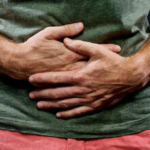Conditions that cause pelvic pain in men can involve the urinary, reproductive, gastrointestinal, musculoskeletal, and nervous systems. Here are the most common causes of pelvic pain in men.
Urinary tract and prostate conditions
Urinary Tract Infection (UTI)
UTIs aren’t just a women’s issue — men can get them too, and one of the common signs is a dull, uncomfortable ache in the lower belly or pelvic area. UTIs happen when bacteria get into your urinary tract (like your bladder or urethra), often causing a burning feeling when you pee, the need to go more often (especially at night), and/or pee that looks cloudy or smells odd. They can sometimes be complications of other issues, like an enlarged prostate. UTIs are usually treated with antibiotics, so you should see your doctor.
Cystitis
Cystitis is when your bladder gets inflamed, and it can cause pelvic pain that feels like pressure or aching just above the pubic bone. Alongside the pelvic discomfort, you might notice you’re peeing more often, it might sting when you go and sometimes there can even be blood in your urine. In males, cystitis is usually caused by a bacterial infection, so you should see your doctor because antibiotics are the best treatment.
Prostatitis
Prostatitis is inflammation of the prostate gland and it’s a common cause of pelvic pain in men. The pain can show up between the scrotum and the rectum, around the lower back, or just as a general ache in the pelvic area. It can come on suddenly (acute prostatitis), often with fever and chills, or drag on over time (chronic prostatitis). Other symptoms include pain when peeing or ejaculating, needing to pee often, and sometimes flu-like symptoms. Treatment depends on the cause — antibiotics for bacterial cases, and pain relief or pelvic physiotherapy for chronic cases.
Benign Prostatic Hyperplasia (BPH)
BPH is when the prostate gland gets bigger (which becomes more common as men age) and can press on the bladder or urethra, leading to pelvic discomfort or a heavy feeling in the lower belly. It can also cause a weak urine stream, trouble starting or stopping the flow, needing to pee a lot (especially at night), and sometimes pain after ejaculating. BPH isn’t cancer, but it can be annoying and affect your daily life. Treatment might involve medication to relax the prostate or shrink it, and in more serious cases, surgery.
Sexually transmitted infections (STIs)
Chlamydia and gonorrhea
These two common sexually transmitted infections (STIs) are caused by bacteria passed on through unprotected sex and often show up with similar symptoms — including a burning feeling when you pee, discharge from the tip of the penis, and sometimes pain or swelling in the testicles. Both chlamydia and gonorrhea can also cause pelvic pain in men, usually felt as a dull ache or discomfort in the lower belly or around the groin. Some men don’t notice any symptoms at all, which is why wearing condoms during sexual activity and regular STI testing is important. The good news is both infections are easily treated with antibiotics, but if left untreated, they can lead to more serious problems like infertility or ongoing pelvic pain.
Subscribe to our newsletter

Musculoskeletal and nerve-related causes
Hernia
An inguinal hernia happens when a bit of tissue — like part of the intestine — pushes through a weak spot in the lower abdominal muscles, often near the groin. This can cause a dull or aching pain in the pelvic area, especially when you lift something heavy, cough, or strain. You might also notice a soft bulge in the groin that gets bigger when you're standing or moving around. Hernias don’t usually go away on their own and might need surgery to fix, especially if they’re causing pain or getting worse, so see your doctor if you recognise these symptoms.
Pudendal nerve entrapment
This is an uncommon but frustrating cause of long-term pelvic pain in men, and it happens when the pudendal nerve — which runs through the pelvis — gets irritated, pinched or damaged. The pain often feels like burning, stabbing or a deep ache, and it usually gets worse when sitting down for long periods (like at work or while driving). Some men also feel numbness or sensitivity in the genitals or between the anus and scrotum. Treatment might include physiotherapy, nerve blocks or medication to help calm the nerve.
Chronic pelvic pain syndrome (CPPS)
CPPS is a term doctors use when a man has ongoing pelvic pain but no clear infection or injury to explain it. The pain might be linked to tense pelvic muscles, nerve irritation, past trauma, or even stress, and it can show up as a constant ache, pressure, or sharp pain in the lower belly, groin or between the legs. It often comes with other symptoms like painful urination, discomfort during or after ejaculation, or trouble sitting for too long. Treatment depends on the cause, but can include physiotherapy, pain relief, stress management and sometimes medication.
Gastrointestinal causes
Irritable bowel syndrome (IBS)
IBS is a gut condition that can cause cramping, bloating and changes in your poo (like diarrhoea, constipation, or a mix of both), and for some men, it also brings on pelvic pain or pressure. The pain often comes and goes, and can be triggered by certain foods, stress, or just the way your gut muscles are working. It doesn’t cause damage to the bowel, but it can be uncomfortable and affect your day-to-day life. While there’s no cure, IBS is usually managed by changing your diet, reducing stress and using medication if needed.
Appendicitis
Appendicitis is when the appendix — a small pouch in your lower right belly — gets inflamed, and it often causes sudden, sharp pain that can start around the belly button and move down to the lower right side. In men, that pain can also feel like it’s coming from the pelvic area. You might also get a fever, feel sick, lose your appetite, or have trouble going to the toilet. Appendicitis is a medical emergency and usually needs surgery to remove the appendix, so it’s important to get checked quickly if you’ve got this kind of pain.
Psychological factors
Stress, anxiety and mental health can play a big role in pelvic pain — either by triggering it or making it feel worse. When you’re stressed, your muscles (including those in the pelvic area) can tighten without you even realising, which may lead to pain, tension or discomfort. Anxiety can also affect how your body processes pain, making you more sensitive to it. This doesn’t mean the pain is “just in your head” but looking after your mental health through stress management, counselling or relaxation techniques can often help ease physical symptoms too. Pain can also impact your mental health and if you're struggling it's important to talk to someone about it, including your doctor.
If you're unsure about what's causing pelvic pain or if it lasts longer than a few days, see a doctor for proper diagnosis and treatment.













